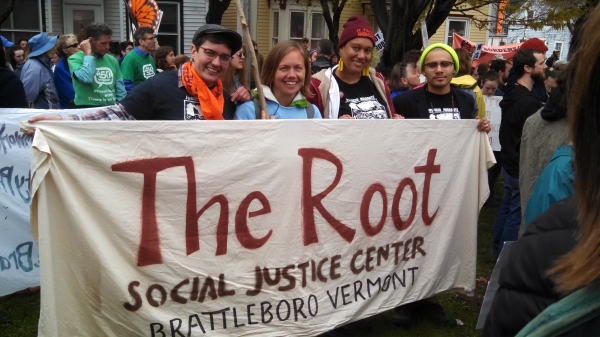BRATTLEBORO — Founded in 2013, The Root Social Justice Center in Brattleboro has opened its doors to nearly two dozen community groups and nonprofits each year. Located on Williams Street, the organization hosts over 80 public events annually. This year, The Root Collective has shifted and narrowed its focus from a wide array of social justice issues toward racial justice organizing more specifically.
Angela Berkfield, one of the co-founders of The Root Social Justice Center, explained how this transition occurred.
“The community was asking The Root to do more speaking and teaching, and be more active in organizing and yet, as an all-volunteer collective, we didn't have extra capacity to do anything else.
“We also were unable to attract more people of color and poor and working class folks to our collective. So we changed our organizing model to diversify our leadership and have a larger impact in the community. We began fundraising to pay the bills.
“There are five of us on the collective, and currently five people on the advisory board. We began programming specific to building leadership for people of color in the local area.”
Good timing
The shift in focus at the Root occurred prior to the heated 2016 presidential election, “but,” Berkfield said, “it was good timing, because we were able to respond more directly and do more organizing specifically because of the current political climate.”
The Root writes clearly and emphatically about its current mission on its website.
“We don't yet know what this presidency is going to mean for social justice organizing. However, it is clear that now, more than ever, we must join together to stand strong with frontline communities. Our Muslim, LGBTQ , Immigrant, Women, Black, Indigenous, Jewish, Poor and Working Class neighbors will be under attack both from policies and on the streets. And the earth that we all live on is in grave danger from reckless climate change denial.”
At The Root, racial justice organizing is now front-and-center.
“Our approach at the Root is to shift leadership and decision making and financial and other resources to people of color in our community - people who have really been on the front lines of the negative impacts of racism for centuries,”Berkfield said.
With that goal in mind, The Root makes leadership by people of color a top priority, as well as transferring resources to racial-justice causes led by people of color.
The organization has worked toward, and maintained, a majority of people of color on their collective and advisory boards. Right now, of the nine people in leadership, six are people of color.
“Our programs,” Berkfield said, “provide space for people to heal, build community and trust, and then begin to identify what it is that they want to take action on.”
The organization is part of a coalition of groups that are working on racial justice issues - a group of white allies - Lost River Racial Justice - as well as the Southern Vermont chapter of Black Lives Matter.
In cooperation with the other groups, the Root has led rallies and protests in response to local KKK provocations and to the murders of black men killed by police in the U.S. during the summer of 2016. Supporting the protests at Standing Rock, and Migrant Justice's continued push for implementation of Fair and Impartial Policing and the Milk with Dignity Campaign, have been a part of the group's work as well.
Current programming
The Root is in the beginning stages of assembling programs. There is a once-a-month gathering for people of color called Soul Food Sunday on the fourth Sunday of each month.
Berkfield said enthusiastically that it has had a great turnout. “There's also a youth group (Youth 4 Change) that's not specific to people of color, but it's led by people of color, and there are many youth of color. We prioritize having youth on our board as well.”
An additional program put on by The Root is “I am Vermont Too,” a photo/story project that has been hung in the State House, “which highlights photos of people of color holding signs that show microaggression[s] that they've experienced in Vermont.”
This too, she said, serves to educate the public about the more-subtle yet still challenging ways in which people of color are affected by racism in Vermont.
Other programming includes a community organizing space, social justice forums, and a radical lending library.
In the current sociopolitical climate, social justice centers face many issues.
“The reality is that what's been going on now has been going on for centuries,” Berkfield said. “Yet many white people were thinking that racism was a thing of the past, and that it didn't really have too much to do with them.
“It has become clear to many people that racism is real, and it is rooted in the way our institutions in this country operate. We've been doing this work for a long time, and for us it's really energizing to have so many people seeing what we are seeing, and taking action. So, in many ways, we're more hopeful now than before.”
